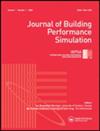基于深度强化学习的暖通空调系统节能权衡决策
IF 2.3
4区 工程技术
Q2 CONSTRUCTION & BUILDING TECHNOLOGY
引用次数: 8
摘要
本文介绍了基于模型的强化学习(MB-RL)技术来控制室内空气温度和二氧化碳浓度水平,同时最大限度地减少供暖、通风和空调(HVAC)系统的能耗。为此,在保持室内舒适度和最大限度地减少能源消耗之间进行权衡。采用确定性策略RL (DP-RL)方法对暖通空调系统进行控制。此外,采用非线性自回归外生神经网络(NARX-NN)作为近似函数,结合DP-RL方法,给出了混合DP-NARX-RL控制器。通过将DP-RL和DP-NARX-RL控制器应用于典型建筑的HVAC系统,在两个案例研究中评估了室内舒适度、电力、能源消耗以及不同定价方案下的能源成本等参数。在这两种情况下,结果表明DP-NARX-RL与DP-RL、RL和PID控制器相比性能更好。本文章由计算机程序翻译,如有差异,请以英文原文为准。
Trade-off decisions in a novel deep reinforcement learning for energy savings in HVAC systems
This paper presents Model-based Reinforcement Learning (MB-RL) techniques to control the indoor air temperature, and CO2 concentration level, and minimize the energy consumption of the heating, ventilating, and air conditioning (HVAC) systems, simultaneously. For this purpose, a trade-off is made between maintaining indoor comfort levels and minimizing energy consumption. The control of the HVAC system is performed using the Deterministic Policy RL (DP-RL) method. Moreover, the nonlinear autoregressive exogenous neural network (NARX-NN) is employed as an approximation function with DP-RL method to provide a hybrid DP-NARX-RL controller. By applying the DP-RL and DP-NARX-RL controllers to the HVAC system of a typical building, parameters such as the indoor comfort levels, the electrical power, and energy consumed, and the energy costs at various pricing schemes are evaluated for two case studies. In both cases, the results show the better performance of DP-NARX-RL compared to DP-RL, RL, and PID controllers.
求助全文
通过发布文献求助,成功后即可免费获取论文全文。
去求助
来源期刊

Journal of Building Performance Simulation
CONSTRUCTION & BUILDING TECHNOLOGY-
CiteScore
5.50
自引率
12.00%
发文量
55
审稿时长
12 months
期刊介绍:
The Journal of Building Performance Simulation (JBPS) aims to make a substantial and lasting contribution to the international building community by supporting our authors and the high-quality, original research they submit. The journal also offers a forum for original review papers and researched case studies
We welcome building performance simulation contributions that explore the following topics related to buildings and communities:
-Theoretical aspects related to modelling and simulating the physical processes (thermal, air flow, moisture, lighting, acoustics).
-Theoretical aspects related to modelling and simulating conventional and innovative energy conversion, storage, distribution, and control systems.
-Theoretical aspects related to occupants, weather data, and other boundary conditions.
-Methods and algorithms for optimizing the performance of buildings and communities and the systems which service them, including interaction with the electrical grid.
-Uncertainty, sensitivity analysis, and calibration.
-Methods and algorithms for validating models and for verifying solution methods and tools.
-Development and validation of controls-oriented models that are appropriate for model predictive control and/or automated fault detection and diagnostics.
-Techniques for educating and training tool users.
-Software development techniques and interoperability issues with direct applicability to building performance simulation.
-Case studies involving the application of building performance simulation for any stage of the design, construction, commissioning, operation, or management of buildings and the systems which service them are welcomed if they include validation or aspects that make a novel contribution to the knowledge base.
 求助内容:
求助内容: 应助结果提醒方式:
应助结果提醒方式:


